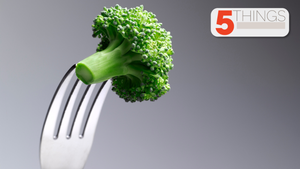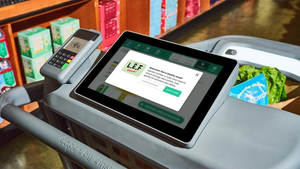PRODUCE PALS
RETAILERS EAGER TO DEMONSTRATE their commitment to health and wellness often turn first to the produce department. The abundant displays, vibrant colors and global variety make it the ideal platform from which supermarkets can promote better living for their customers. The nutritional benefits of fresh fruits and vegetables are well known to consumers, and reinforced constantly by government researchers,
April 28, 2008
ROBERT VOSBURGH
RETAILERS EAGER TO DEMONSTRATE their commitment to health and wellness often turn first to the produce department. The abundant displays, vibrant colors and global variety make it the ideal platform from which supermarkets can promote better living for their customers. The nutritional benefits of fresh fruits and vegetables are well known to consumers, and reinforced constantly by government researchers, lifestyle experts and even celebrities.
Stores have steadily increased the department's footprint over the years, and with that have come financial advantages: In 2006, median sales were $41,500 a week, and the department's contribution to total store sales grew to 10.6% — up from 9.8% in 2001, according to the Food Marketing Institute.
Numbers like these mean a lot of vendors want to get into produce — even if they're not necessarily in the fresh business. Manufacturers of soy products, snacks, juices and baby food are among those clamoring to gain a toehold in the department.
Their reasons are legitimate. Produce is first in the shopping pattern, hosts the most colorful products in the store, and shouts freshness and health.
“Produce is the nucleus of our stores,” said Colein Whicher, spokeswoman for Sunflower Farmers Market, a 14-store chain headquartered in Boulder, Colo. “It's right in the center, so where conventional stores typically have produce lined up in a wall of coolers, we only have the back wall with a wet rack. The rest of the department extends into the middle of the store.”
That kind of talk enchants manufacturers, who like to believe their chances of getting their products into the basket are much greater in perimeter departments like produce, as opposed to being mixed into the grocery aisles.
“Manufacturers can justify any grocery item in the produce department,” said Dick Spezzano, a produce consultant and former retailer. “What they try to do is change the look, from glass to plastic, or canned to jarred, to try to give it a fresh image.”
That's exactly what Michael Mockler experienced as director of produce for Thrifty Foods, Victoria, British Columbia. During a pork promotion last year, Mockler had his department participate by merchandising jars of applesauce adjacent to a fresh apple display.
“As soon as you do that, for some reason the applesauce becomes fresher,” he said. “Every time you take a grocery product into produce, the same thing happens.”
However, too much thinking like that can turn the produce department into an extension of grocery. “You could have a whole store there with that idea — putting potato chips with potatoes, that kind of thing,” Mockler said.
Produce managers often find themselves facing such propositions. What's good and what's clutter? What's getting in the way and what's actually helping the department's true goal, selling fresh fruit and vegetables? Mockler believes some produce-related items, like fresh juices, are a natural fit.
“They're great for the produce department, where you usually have a lot of cheap commodities like green onions or radishes,” he said. “And because they're considered super-premium, you can charge a grocery margin.”
Most Thrifty stores offer a 4-foot, multi-deck section of juices, which account for about 0.5% of produce department sales, he added. As a department, produce contributes an above-average 15% to total-store sales.
Indeed, super-premium juices based on the superfruit antioxidants açai or pomegranate are among the favorite ancillary items mentioned by produce managers, along with nuts and soy. And, even though they may fail the healthfulness test, full-fat refrigerated salad dressings are also on the list, if they're organic. Mockler notes that today's produce department is almost expected to carry a certain number of items beyond fresh fruits and vegetables.
“If you're going to be in the business, you've got to merchandise it correctly, have the variety people want and keep the dates right,” he said, adding that Thrifty constantly faces space challenges. Each of the 20 stores in the chain averages 25,000 square feet; produce sections run about 1,800 square feet. These departments are crowded with roughly 800 SKUs, 80 of which are organic on any given day.
Such space constraints mean retailers have to pick and choose carefully to maximize the impact their departments make. While fresh is the emphasis during the height of the growing season, it's during the colder months that consumers are apt to see more prepared-food items in produce.
“The grocery guy might get it and not really care, since this is just one of the 20,000 items he's dealing with every day,” observed Ray Klocke, an industry consultant and retired vice president of produce and floral for Safeway. “But if the produce guy gets it, it might mean extra sales, and it's something he can promote when he doesn't have all the in-season, summer fruits to sell.”
Simple logic also plays a role in determining what ancillary products get stocked in produce. For example, soy items like tofu are usually merchandised in refrigerated produce cases because the primary consumer of soy is often vegetarian. Logistics is another consideration.
“Some products fall into the produce department's hands because they can be delivered to the warehouse more frequently, sent out to stores five days a week, stocked and turned as needed — much like actual produce is,” said Spezzano, noting that profits are protected in this case because these products can stand up to higher pricing, and better in-store attention means lower rates of shrink.
“You just can't do that in grocery,” he said.
The challenge for managers is to determine not only which healthful items are appropriate for produce, but how best to merchandise the products that make the cut.
“Someone who says they'll just put in 90 organic SKUs, they're going to shrink most of the profit away, with one or two exceptions,” observed Frank McCarthy, vice president of marketing at Albert's Organics. If organic produce is a $2 billion business, then he estimates sales of related items in the department approach $100 million.
“When you add it all up, the organic salad dressings, the dried fruit and the juices, you're probably talking 4% or 5% of total produce,” he said.
Managers aren't attracted to ancillary products because of margins alone. They like the idea that some of the SKUs they are responsible for don't have to be constantly trimmed and rotated.
“Many of these products are dried, bottled or jarred, and so last longer than fresh organic produce,” continued McCarthy. “The margins are probably about the same as fresh, but the shrink is less, so the take-home is better.”
At a Kroger-owned Ralphs store in Orange, Calif., related items complemented the fresh produce on display. In a cooler, premium juices were found next to bagged salads. All sorts of peelers, zesters and pitters hung on pegs above displays. Multi-tiered wooden boxes were used to hold plastic trays of dried fruits, nuts and trail mixes.
“Oftentimes there will be shelving, and that's where these items go,” said Spezzano, who is based in California and is familiar with Ralphs. “They don't have high sales, but they utilize dead space. It doesn't take away from the real business, but it finds a home, and it does sell.”
At Sunflower Farmers Market, fresh produce remains the primary focus, with fewer ancillary items than are found in a Ralphs or other conventional stores. Whicher, the spokeswoman, says this is because Sunflower has chosen to adopt a simpler merchandising program that provides it a degree of authenticity not found in competing retailers.
“Most of the produce is out on tables without refrigeration, because it's such a quick turn for us,” she said.
When seasonal demands require more refrigeration, the chain wheels mobile coolers out onto the floor.
Retailers with a bit of extra space have been able to build wellness departments adjacent to the produce section, sharing refrigerated walls and shifting some of the ancillary items over to the natural displays.
“To me, it's all an incremental business,” said Mockler. “Who wants a whole pile of shippers sitting in their display area?”
Experts advise retailers that if they stock ancillary items in produce, they should prepare not only a clearly defined promotional and marketing plan, but a concise merchandising strategy as well, where the focus is on the fresh, and incremental products won't overpower the display.
“The customer isn't going to remember you for your apple dip,” said Spezzano. “They'll remember if you did a good job on apples.”
Good Advice
Stock items that compensate for off-season times when fresh produce is less available.
Keep fresh produce the focus; avoid overwhelming displays with related items.
Regular rotation keeps the department interesting and entices shoppers to “treasure hunt.”
Surprise consumers! Try unique pairings like wine and berries in summer, or cheese and apples in the fall.
About the Author
You May Also Like




